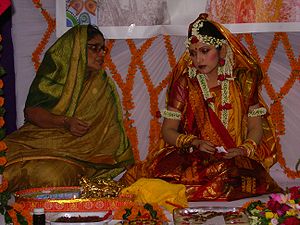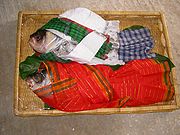
Gaye Holud
Encyclopedia

Ceremony
A ceremony is an event of ritual significance, performed on a special occasion. The word may be of Etruscan origin.-Ceremonial occasions:A ceremony may mark a rite of passage in a human life, marking the significance of, for example:* birth...
observed mostly in the region of Bengal
Bengal
Bengal is a historical and geographical region in the northeast region of the Indian Subcontinent at the apex of the Bay of Bengal. Today, it is mainly divided between the sovereign land of People's Republic of Bangladesh and the Indian state of West Bengal, although some regions of the previous...
(comprising Bangladesh
Bangladesh
Bangladesh , officially the People's Republic of Bangladesh is a sovereign state located in South Asia. It is bordered by India on all sides except for a small border with Burma to the far southeast and by the Bay of Bengal to the south...
and India
India
India , officially the Republic of India , is a country in South Asia. It is the seventh-largest country by geographical area, the second-most populous country with over 1.2 billion people, and the most populous democracy in the world...
n West Bengal
West Bengal
West Bengal is a state in the eastern region of India and is the nation's fourth-most populous. It is also the seventh-most populous sub-national entity in the world, with over 91 million inhabitants. A major agricultural producer, West Bengal is the sixth-largest contributor to India's GDP...
). It is part of an elaborate series of celebrations constituting the Bengali wedding
Bengali wedding
Bengali wedding includes many rituals and ceremonies that can span several days. Although Muslim and Hindu marriages have their distinctive religious rituals, there are many common Bengali rituals in weddings across both West Bengal and Bangladesh....
. The gaye holud takes place one or two days prior to the religious and legal Bengali wedding ceremonies. The gaye holud may be a joint event for the bride and groom's families, or it may consist of separate events for the bride's family and the groom's family.
Separate Events:
For the bride's
Bride
A bride is a woman about to be married or newlywed.The word may come from the Proto-Germanic verb root *brū-, meaning 'to cook, brew, or make a broth' which was the role of the daughter-in-law in primitive families...
gaye holud, the groom's family - minus the groom himself - go in procession to the bride's home. They carry with them the bride's wedding outfit and jewelry, wedding decorations such as the turmeric
Turmeric
Turmeric is a rhizomatous herbaceous perennial plant of the ginger family, Zingiberaceae. It is native to tropical South Asia and needs temperatures between 20 °C and 30 °C and a considerable amount of annual rainfall to thrive...
paste ( holud) and henna
Henna
Henna is a flowering plant used since antiquity to dye skin, hair, fingernails, leather and wool. The name is also used for dye preparations derived from the plant, and for the art of temporary tattooing based on those dyes...
( mehedi/mendi), costmetics, sweets and other gifts. They may also bring fresh fish
Fish
Fish are a paraphyletic group of organisms that consist of all gill-bearing aquatic vertebrate animals that lack limbs with digits. Included in this definition are the living hagfish, lampreys, and cartilaginous and bony fish, as well as various extinct related groups...
dressed as a wedding couple, or desserts molded to resemble fish. The procession traditionally centers on the bride's (younger) female relatives and friends, who traditionally dress in matching clothes. The bride, her attendees, and all the guests traditionally wear red, yellow, orange, or green clothing. Nowadays, other colours may be permitted for gaye holud guests. The guests then enjoy a feast, including music, dance and some performances, arranged by the bride's family.

Dais
Dais is any raised platform located either in or outside of a room or enclosure, often for dignified occupancy, as at the front of a lecture hall or sanctuary....
, and the henna is used to decorate her hands and feet with elaborate abstract designs. The turmeric paste is applied by the guests to her face and body. Tumeric is known to cleanse, soften and brighten the skin, giving the bride's skin the distinctive yellow hue that gives its name to this ceremony. The sweets are then fed to the bride by all the guests and attendants, piece by piece.
The groom's gaye holud comes next, and has the same form as the bride's holud ceremony. In this ceremony, the bride does not participate. The groom is accompanied by his younger male relatives and friends, and as with the bride's ceremony, the guests traditionally wear red, yellow, green, or orange clothing. The bride's family brings the gifts for the groom (usually the wedding outfit and some grooming items, along with the tumeric and other gifts) to his house. The guests exchange sweets with and apply turmeric paste to the groom, and a feast (with food, music, dance, and various cultural performances) is arranged for the guests from the groom's family. Unlike the bride, the groom does not get henna applied to his body; henna is only applied to the bride and perhaps also some of her younger female attendants.
Although similar ceremonies exist in other parts of the Indian subcontinent
Indian subcontinent
The Indian subcontinent, also Indian Subcontinent, Indo-Pak Subcontinent or South Asian Subcontinent is a region of the Asian continent on the Indian tectonic plate from the Hindu Kush or Hindu Koh, Himalayas and including the Kuen Lun and Karakoram ranges, forming a land mass which extends...
, the gaye holud is a custom particular to the Bengali people
Bengali people
The Bengali people are an ethnic community native to the historic region of Bengal in South Asia. They speak Bengali , which is an Indo-Aryan language of the eastern Indian subcontinent, evolved from the Magadhi Prakrit and Sanskrit languages. In their native language, they are referred to as বাঙালী...
. It is not considered a religious
Religion
Religion is a collection of cultural systems, belief systems, and worldviews that establishes symbols that relate humanity to spirituality and, sometimes, to moral values. Many religions have narratives, symbols, traditions and sacred histories that are intended to give meaning to life or to...
function, as it is celebrated by Muslims
Islam
Islam . The most common are and . : Arabic pronunciation varies regionally. The first vowel ranges from ~~. The second vowel ranges from ~~~...
, Hindu
Hindu
Hindu refers to an identity associated with the philosophical, religious and cultural systems that are indigenous to the Indian subcontinent. As used in the Constitution of India, the word "Hindu" is also attributed to all persons professing any Indian religion...
s, and Christian
Christian
A Christian is a person who adheres to Christianity, an Abrahamic, monotheistic religion based on the life and teachings of Jesus of Nazareth as recorded in the Canonical gospels and the letters of the New Testament...
s in both Bangladesh and Indian West Bengal. Although it is considered a part of the Bengali wedding tradition, the couple is not considered married at the end of the gaye holud. There is no legal marriage performed during this ceremony. Unlike the wedding ceremonies, the gaye holud is not a formal or extravagant event; both guests and bridal party members dress more simply and decorate the venue less intricately than at the wedding ceremonies.
See also
- Bengali weddingBengali weddingBengali wedding includes many rituals and ceremonies that can span several days. Although Muslim and Hindu marriages have their distinctive religious rituals, there are many common Bengali rituals in weddings across both West Bengal and Bangladesh....
- Culture of BangladeshCulture of BangladeshBangladesh has a long history in its culture. The land, the rivers, and the lives of the common people formed a rich heritage with marked differences from neighbouring regions. It has evolved over the centuries and encompasses the cultural diversity of several social groups of Bangladesh...
- Culture of West BengalCulture of West BengalThe culture of West Bengal is an Indian Culture which has its roots in the Bengali literature, music, fine arts, drama and cinema. People of West Bengal share their cultural heritage with the neighbouring Bangladesh . West Bengal has a long tradition of popular literature, music and drama largely...

